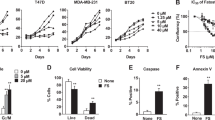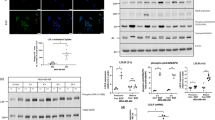Abstract
The specific role of dietary fat in breast cancer progression is unclear, although a low-fat diet was associated with decreased recurrence of estrogen receptor alpha negative (ER−) breast cancer. ER− basal-like MDA-MB-231 and MDA-MB-436 breast cancer cell lines contained a greater number of cytoplasmic lipid droplets compared to luminal ER+ MCF-7 cells. Therefore, we studied lipid storage functions in these cells. Both triacylglycerol and cholesteryl ester (CE) concentrations were higher in the ER− cells, but the ability to synthesize CE distinguished the two types of breast cancer cells. Higher baseline, oleic acid- and LDL-stimulated CE concentrations were found in ER− compared to ER+ cells. The differences corresponded to greater mRNA and protein levels of acyl-CoA:cholesterol acyltransferase 1 (ACAT1), higher ACAT activity, higher caveolin-1 protein levels, greater LDL uptake, and lower de novo cholesterol synthesis in ER− cells. Human LDL stimulated proliferation of ER− MDA-MB-231 cells, but had little effect on proliferation of ER+ MCF-7 cells. The functional significance of these findings was demonstrated by the observation that the ACAT inhibitor CP-113,818 reduced proliferation of breast cancer cells, and specifically reduced LDL-induced proliferation of ER− cells. Taken together, our studies show that a greater ability to take up, store and utilize exogenous cholesterol confers a proliferative advantage to basal-like ER− breast cancer cells. Differences in lipid uptake and storage capability may at least partially explain the differential effect of a low-fat diet on human breast cancer recurrence.




Similar content being viewed by others
References
Tosi MR, Tugnoli V (2005) Cholesteryl esters in malignancy. Clin Chim Acta 359:27–45
Freeman MR, Cinar B, Kim J, Mukhopadhyay NK, Di Vizio D, Adam RM, Solomon KR (2007) Transit of hormonal and EGF receptor-dependent signals through cholesterol-rich membranes. Steroids 72:210–217
Firestone RA (1994) Low-density lipoprotein as a vehicle for targeting antitumor compounds to cancer cells. Bioconjug Chem 5:105–113
Brown MS, Ho YK, Goldstein JL (1980) The cholesteryl ester cycle in macrophage foam cells. Continual hydrolysis and re-esterification of cytoplasmic cholesteryl esters. J Biol Chem 255:9344–9352
Frank PG, Cheung MW, Pavlides S, Llaverias G, Park DS, Lisanti MP (2006) Caveolin-1 and regulation of cellular cholesterol homeostasis. Am J Physiol Heart Circ Physiol 291:H677–H686
Dessi S, Batetta B, Pani A, Spano O, Sanna F, Putzolu M, Bonatesta R, Piras S, Pani P (1997) Role of cholesterol synthesis and esterification in the growth of CEM and MOLT4 lymphoblastic cells. Biochem J 321(Pt 3):603–608
Batetta B, Pani A, Putzolu M, Sanna F, Bonatesta R, Piras S, Spano O, Mulas MF, Dessi S (1999) Correlation between cholesterol esterification, MDR1 gene expression and rate of cell proliferation in CEM and MOLT4 cell lines. Cell Prolif 32:49–61
Stranzl A, Schmidt H, Winkler R, Kostner GM (1997) Low-density lipoprotein receptor mRNA in human breast cancer cells: influence by PKC modulators. Breast Cancer Res Treat 42:195–205
Rotheneder M, Kostner GM (1989) Effects of low- and high-density lipoproteins on the proliferation of human breast cancer cells in vitro: differences between hormone-dependent and hormone-independent cell lines. Int J Cancer 43:875–879
Chajes V, Mahon M, Kostner GM (1996) Influence of LDL oxidation on the proliferation of human breast cancer cells. Free Radic Biol Med 20:113–120
Sorlie T, Wang Y, Xiao C, Johnsen H, Naume B, Samaha RR, Borresen-Dale AL (2006) Distinct molecular mechanisms underlying clinically relevant subtypes of breast cancer: gene expression analyses across three different platforms. BMC Genomics 7:127
Hu Z, Fan C, Oh DS, Marron JS, He X, Qaqish BF, Livasy C, Carey LA, Reynolds E, Dressler L, Nobel A, Parker J, Ewend MG, Sawyer LR, Wu J, Liu Y, Nanda R, Tretiakova M, Ruiz Orrico A, Dreher D, Palazzo JP, Perreard L, Nelson E, Mone M, Hansen H, Mullins M, Quackenbush JF, Ellis MJ, Olopade OI, Bernard PS, Perou CM (2006) The molecular portraits of breast tumors are conserved across microarray platforms. BMC Genomics 7:96
Sorlie T, Tibshirani R, Parker J, Hastie T, Marron JS, Nobel A, Deng S, Johnsen H, Pesich R, Geisler S, Demeter J, Perou CM, Lonning PE, Brown PO, Borresen-Dale AL, Botstein D (2003) Repeated observation of breast tumor subtypes in independent gene expression data sets. Proc Natl Acad Sci USA 100:8418–8423
Foulkes WD, Stefansson IM, Chappuis PO, Begin LR, Goffin JR, Wong N, Trudel M, Akslen LA (2003) Germline BRCA1 mutations and a basal epithelial phenotype in breast cancer. J Natl Cancer Inst 95:1482–1485
Folch J, Lees M, Sloane Stanley GH (1957) A simple method for the isolation and purification of total lipides from animal tissues. J Biol Chem 226:497–509
Carr TP, Andresen CJ, Rudel LL (1993) Enzymatic determination of triglyceride, free cholesterol, and total cholesterol in tissue lipid extracts. Clin Biochem 26:39–42
Temel RE, Gebre AK, Parks JS, Rudel LL (2003) Compared with acyl-CoA: cholesterol O-acyltransferase (ACAT) 1 and lecithin: cholesterol acyltransferase, ACAT2 displays the greatest capacity to differentiate cholesterol from sitosterol. J Biol Chem 278:47594–47601
Antalis CJ, Arnold T, Lee B, Buhman KK, Siddiqui RA (2009) Docosahexaenoic acid is a substrate for ACAT1 and inhibits cholesteryl ester formation from oleic acid in MCF-10A cells. Prostaglandins Leukot Essent Fatty Acids 80:165–171
Rasband WS (1997–2009) ImageJ. U. S. National Institutes of Health, Bethesda
Rago R, Mitchen J, Wilding G (1990) DNA fluorometric assay in 96-well tissue culture plates using Hoechst 33258 after cell lysis by freezing in distilled water. Anal Biochem 191:31–34
Rhodes DR, Yu J, Shanker K, Deshpande N, Varambally R, Ghosh D, Barrette T, Pandey A, Chinnaiyan AM (2004) ONCOMINE: a cancer microarray database and integrated data-mining platform. Neoplasia 6:1–6
Elstrodt F, Hollestelle A, Nagel JH, Gorin M, Wasielewski M, van den Ouweland A, Merajver SD, Ethier SP, Schutte M (2006) BRCA1 mutation analysis of 41 human breast cancer cell lines reveals three new deleterious mutants. Cancer Res 66:41–45
Blouin CM, Le Lay S, Lasnier F, Dugail I, Hajduch E (2008) Regulated association of caveolins to lipid droplets during differentiation of 3T3-L1 adipocytes. Biochem Biophys Res Commun 376:331–335
Pol A, Martin S, Fernandez MA, Ingelmo-Torres M, Ferguson C, Enrich C, Parton RG (2005) Cholesterol and fatty acids regulate dynamic caveolin trafficking through the Golgi complex and between the cell surface and lipid bodies. Mol Biol Cell 16:2091–2105
Pinilla SM, Honrado E, Hardisson D, Benitez J, Palacios J (2006) Caveolin-1 expression is associated with a basal-like phenotype in sporadic and hereditary breast cancer. Breast Cancer Res Treat 99:85–90
Savage K, Lambros MB, Robertson D, Jones RL, Jones C, Mackay A, James M, Hornick JL, Pereira EM, Milanezi F, Fletcher CD, Schmitt FC, Ashworth A, Reis-Filho JS (2007) Caveolin 1 is overexpressed and amplified in a subset of basal-like and metaplastic breast carcinomas: a morphologic, ultrastructural, immunohistochemical, and in situ hybridization analysis. Clin Cancer Res 13:90–101
Tan DS, Marchio C, Jones RL, Savage K, Smith IE, Dowsett M, Reis-Filho JS (2008) Triple negative breast cancer: molecular profiling and prognostic impact in adjuvant anthracycline-treated patients. Breast Cancer Res Treat 111:27–44
Elsheikh SE, Green AR, Rakha EA, Samaka RM, Ammar AA, Powe D, Reis-Filho JS, Ellis IO (2008) Caveolin 1 and Caveolin 2 are associated with breast cancer basal-like and triple-negative immunophenotype. Br J Cancer 99:327–334
Charafe-Jauffret E, Ginestier C, Monville F, Finetti P, Adelaide J, Cervera N, Fekairi S, Xerri L, Jacquemier J, Birnbaum D, Bertucci F (2006) Gene expression profiling of breast cell lines identifies potential new basal markers. Oncogene 25:2273–2284
Neve RM, Chin K, Fridlyand J, Yeh J, Baehner FL, Fevr T, Clark L, Bayani N, Coppe JP, Tong F, Speed T, Spellman PT, DeVries S, Lapuk A, Wang NJ, Kuo WL, Stilwell JL, Pinkel D, Albertson DG, Waldman FM, McCormick F, Dickson RB, Johnson MD, Lippman M, Ethier S, Gazdar A, Gray JW (2006) A collection of breast cancer cell lines for the study of functionally distinct cancer subtypes. Cancer Cell 10:515–527
Michels KB, Mohllajee AP, Roset-Bahmanyar E, Beehler GP, Moysich KB (2007) Diet and breast cancer: a review of the prospective observational studies. Cancer 109:2712–2749
Cleary MP, Grossmann ME (2009) Minireview: obesity and breast cancer: the estrogen connection. Endocrinology 150:2537–2542
Blackburn GL, Wang KA (2007) Dietary fat reduction and breast cancer outcome: results from the Women’s Intervention Nutrition Study (WINS). Am J Clin Nutr 86:s878–s881
Farwell WR, Scranton RE, Lawler EV, Lew RA, Brophy MT, Fiore LD, Gaziano JM (2008) The association between statins and cancer incidence in a veterans population. J Natl Cancer Inst 100:134–139
Brusselmans K, Timmermans L, Van de Sande T, Van Veldhoven PP, Guan G, Shechter I, Claessens F, Verhoeven G, Swinnen JV (2007) Squalene synthase, a determinant of Raft-associated cholesterol and modulator of cancer cell proliferation. J Biol Chem 282:18777–18785
Richardson AL, Wang ZC, De Nicolo A, Lu X, Brown M, Miron A, Liao X, Iglehart JD, Livingston DM, Ganesan S (2006) X chromosomal abnormalities in basal-like human breast cancer. Cancer Cell 9:121–132
van de Vijver MJ, He YD, van’t Veer LJ, Dai H, Hart AA, Voskuil DW, Schreiber GJ, Peterse JL, Roberts C, Marton MJ, Parrish M, Atsma D, Witteveen A, Glas A, Delahaye L, van der Velde T, Bartelink H, Rodenhuis S, Rutgers ET, Friend SH, Bernards R (2002) A gene-expression signature as a predictor of survival in breast cancer. N Engl J Med 347:1999–2009
Farmer P, Bonnefoi H, Becette V, Tubiana-Hulin M, Fumoleau P, Larsimont D, Macgrogan G, Bergh J, Cameron D, Goldstein D, Duss S, Nicoulaz AL, Brisken C, Fiche M, Delorenzi M, Iggo R (2005) Identification of molecular apocrine breast tumours by microarray analysis. Oncogene 24:4660–4671
van ‘t Veer LJ, Dai H, van de Vijver MJ, He YD, Hart AA, Mao M, Peterse HL, van der Kooy K, Marton MJ, Witteveen AT, Schreiber GJ, Kerkhoven RM, Roberts C, Linsley PS, Bernards R, Friend SH (2002) Gene expression profiling predicts clinical outcome of breast cancer. Nature 415:530–536
Acknowledgments
The authors would like to thank Maureen Harrington and Cary Mariash for helpful discussions. Gene expression data from the public/private consortium, the Expression Project for Oncology, led by the International Genomics Consortium, were included in this study. We thank Pfizer, Inc., for providing the ACAT inhibitor CP-113,818. This study was supported by the Clarian Values Fund for Research.
Author information
Authors and Affiliations
Corresponding author
Additional information
ACAT1 is the commonly used name for acyl-CoA: cholesterol acyltransferase; the gene symbol is SOAT1.
Rights and permissions
About this article
Cite this article
Antalis, C.J., Arnold, T., Rasool, T. et al. High ACAT1 expression in estrogen receptor negative basal-like breast cancer cells is associated with LDL-induced proliferation. Breast Cancer Res Treat 122, 661–670 (2010). https://doi.org/10.1007/s10549-009-0594-8
Received:
Accepted:
Published:
Issue Date:
DOI: https://doi.org/10.1007/s10549-009-0594-8




